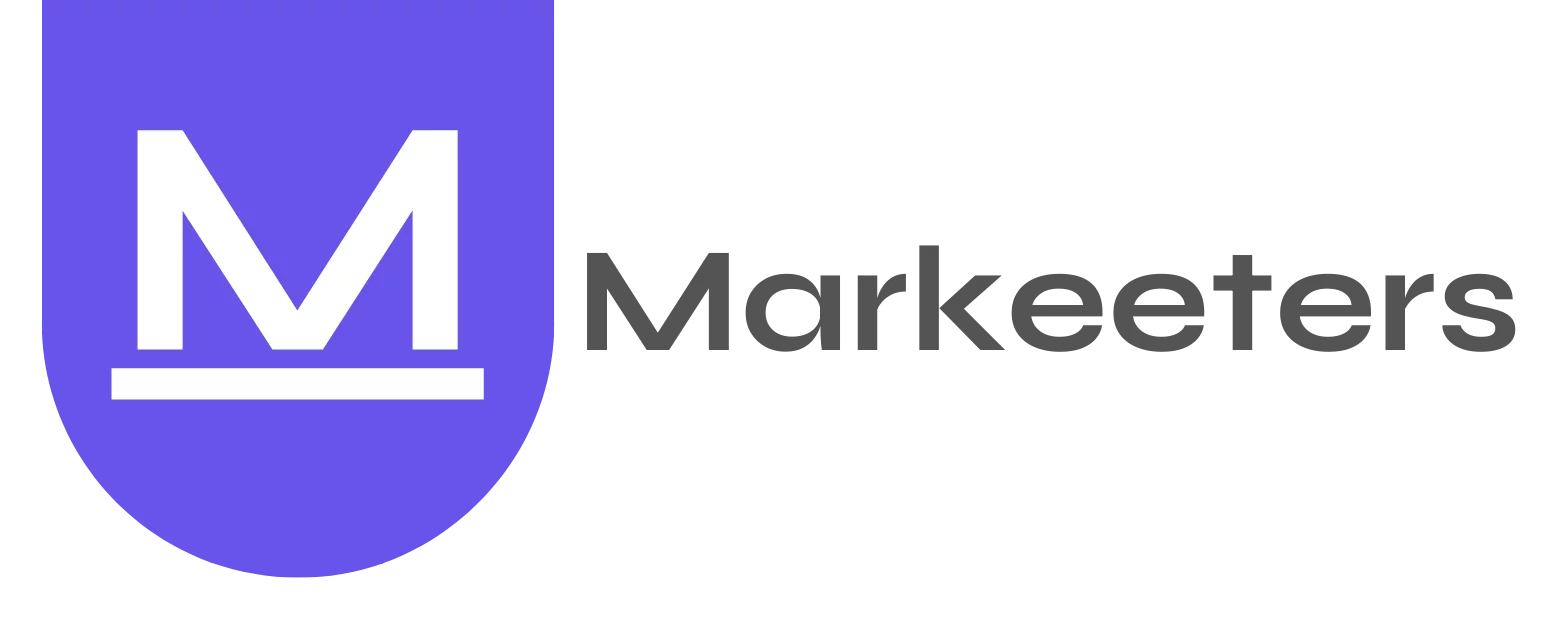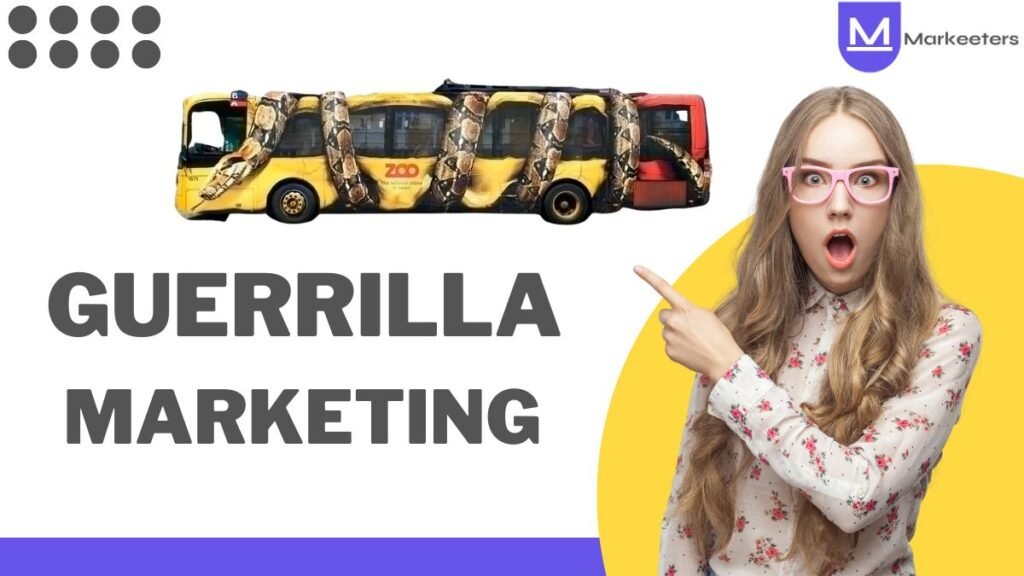As an early-stage startup, resources are limited yet your bold ideas hold immense potential. Effective marketing is crucial for generating awareness and interest, but traditional promotional campaigns consume sizable budgets best spent instead on product development at this stage. Worry not, for there are nimble guerrilla tactics well-suited to startups seeking low-cost, high-impact ways to spread their message.
“Have you ever stumbled upon a flash mob dance break in your local park, leaving with a smile but no idea who organized it? That type of buzz-generating ambush exemplifies the disruptive spirit of guerrilla marketing. Or perhaps you’ve sampled smoothies at a new health food shoppe giving out free cups – directly experiencing a brand in a delightfully unexpected way. Low-cost activations like these creatively reach wider audiences through interactive experiences. As a startup founder, harnessing such untraditional methods can energize your communities outside traditional advertising.“
This article outlines 6 brilliant low-cost guerrilla marketing ideas successfully leveraged by founders like yourselves. We’ll explore ideas like community partnerships, interactive pop-ups, sampling events, and more – all executed creatively at minimal costs. By thinking outside the box and meeting potential customers where they are, these tactics unlocked larger audiences and laid strong foundations for growth.
Guerrilla marketing allows startups to maximize impact using unconventional, low-cost tactics backed by creativity and strategic thinking. Let’s discuss some key elements of guerrilla marketing you must know before planning any such campaign.
Elements of Guerrilla Marketing
Here are some key elements of guerrilla marketing:
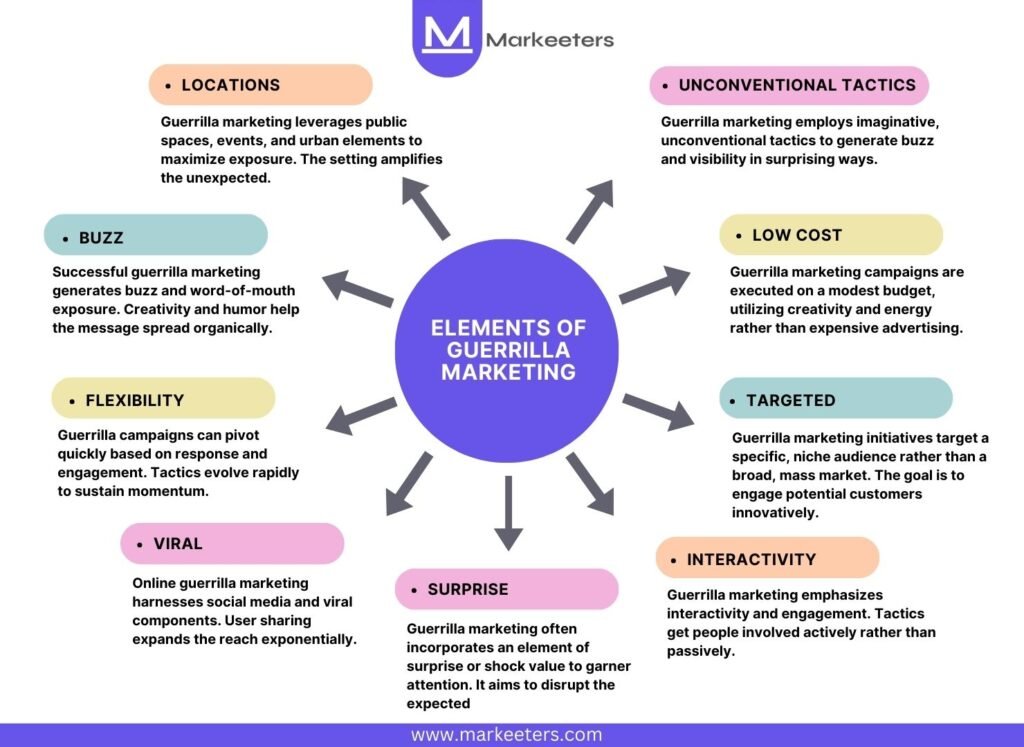
- Unconventional Tactics – Guerrilla marketing uses unconventional, imaginative tactics to promote a product or service. The goal is to create buzz and visibility in unexpected ways.
- Low Cost – Guerrilla marketing is done on a small budget, often just the cost of time and energy. The focus is on high-impact, creative tactics rather than expensive advertising.
- Targeted – Guerrilla marketing campaigns are highly targeted to a specific audience rather than mass-marketed. The goal is to reach potential customers in innovative ways.
- Interactivity – Guerrilla marketing prioritizes interactivity and engagement. Tactics are designed to get people involved and active rather than passive.
- Surprise – An element of surprise or shock is often used to grab attention. Guerrilla marketing disrupts the expected and jars people out of indifference.
- Locations – Guerrilla marketing makes use of public spaces, events, street furniture, and other locations to maximize visibility. The public setting adds to the unexpected nature.
- Buzz – A successful guerrilla campaign generates buzz and word-of-mouth exposure. Creativity and humor help the message spread organically.
- Flexibility – Guerrilla marketing campaigns can shift rapidly based on the response and engagement. Tactics evolve and adapt to sustain visibility.
- Viral – Online guerrilla marketing leverages social media and viral elements. User-generated content and sharing extend the reach exponentially.
The key is connecting with potential customers in smart, creative ways on a limited budget. Guerrilla tactics cut through the noise to deliver impactful brand impressions.
Guerrilla marketing is all about finding unique, buzzworthy ways to promote your brand on a shoestring budget. When executed well, these out-of-the-box tactics can help startups punch above their weight and gain traction despite limited resources.
To know how to plan your marketing budget as a startup read our latest article How to setup marketing budget for your startup

In this piece, we’ll cover several examples of how startups have creatively engaged target audiences using tactics like community events, sample distributions, street marketing, and more. By thinking outside the box and meeting consumers where they are, these ideas unlocked new fans and laid the foundations for future growth. Let’s explore some guerrilla strategies that can help energize your brand as well.
6 Brilliant Low-Cost Guerrilla Marketing Ideas for Startups
1. Leverage Social Media Influencers
Influencer marketing on social media provides startups access to engaged, targeted audiences. However, celebrity influencers can be prohibitively expensive.
Find niche micro-influencers
Instead of mainstream celebs, identify micro-influencers in your niche with smaller but highly engaged followings of 5k to 50k followers. Reach out and offer free products in exchange for reviews and social shares.
For example, a startup selling yoga equipment could send free mats to yogi influencers with 10k followers and get reviews. At $50 per mat, they gain access to 100k+ yoga enthusiasts
Leverage employee advocates
Activate your early employees as brand advocates to share content and run contests on their social channels. Their personal networks will help expand your brand reach.
When tax filing startup Taxfyle started out, they incentivized employees to share FB posts on tax tips which were then liked and shared further by followers.
Engage in community conversations
Have employees jump into relevant conversations where your audience hangs out. Provide value through insightful, non-promotional comments.
For example, a startup selling study abroad packages could share tips and advice in study abroad Facebook groups. This builds affinity.
Guest blog for influencer sites
Approach bloggers and media sites in your space and offer to create long-form guest posts for their audience. Ensure your author bio includes links and credentials.
2. Stage Experiential Marketing Events
Experiential events where consumers can engage with your brand first-hand are great for early-stage awareness. And they can often be executed at low cost.
Local pop-up events
Set up temporary kiosks or booths at local fairs, farmer’s markets, conferences, or public spots. Showcase your products and hand out samples or special promotions.
Jewelry startup AUrate hosted pop-up “try on” booths at subway stations where women could try jewelry before their daily commute.
Street marketing tactics
Use street teams to hand out samples or conduct contests, demonstrations, etc. at high footfall hotspots.
When launching in NYC, café chain BLKdot Coffee drove buzz by having baristas do street performances with coffee brewing techniques at Union Square.
Partnership events
Team up with complementary brands in your space to co-host events, expanding the reach for both.
A health food startup could partner with yoga studios to host nutrition-themed events. Or a fitness wearable could collaborate with gyms.
3. Employ Real-World Tactics
Creatively tap into real-world touchpoints where your audience spends time.
Flyering at local hangouts
Distribute eye-catching flyers for your business at places your audience frequents – gyms, college campuses, bars, events, etc. Include special discount codes or flash sales to drive immediate conversions.
When launching, fashion retailer Everlane blanketed cafes in their HQ city with flyers offering a 15% discount. The flyers were too attractive to discard.
Impromptu product demos
For tangible products, launch impromptu demos at local public spaces. Let consumers engage and experience products first-hand.
Skincare startups often hire brand ambassadors to demonstrate product applications and benefits to women in the cosmetics section of department stores.
Branded car wraps
Have a car fully wrapped with your branding along with a compelling tagline and visuals. The roaming billboard effect can capture attention.
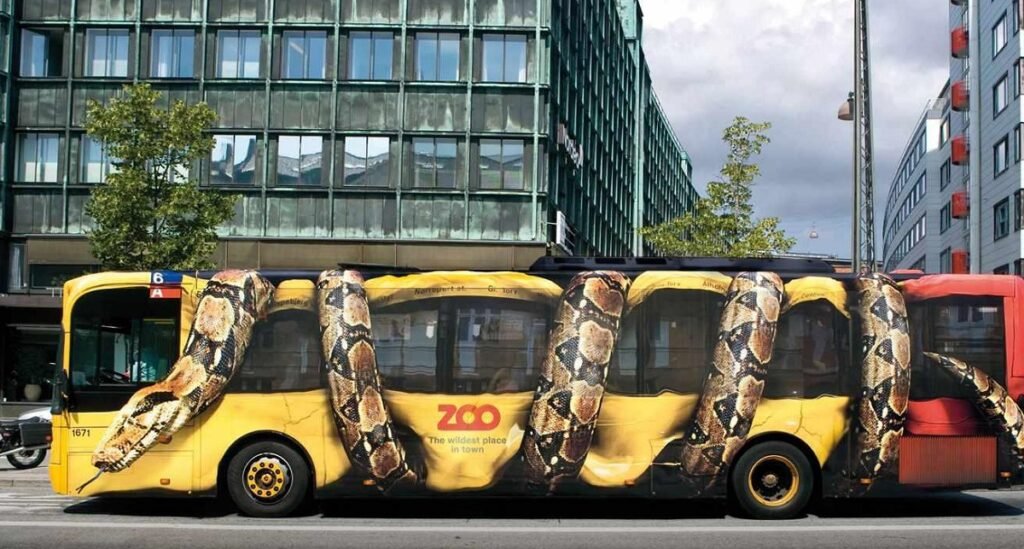
In 2010, The Copenhagen Zoo got a unique design for its bus.
The idea for this design came from Art Director Peter Schak. He aimed to make a big impression without spending a lot of money, which is a common tactic in guerrilla marketing.
First, they wanted it to appear very realistic, so they took really clear pictures of the bus.
Then, they added an image of a huge boa constrictor to make it seem like the snake was squeezing the bus.
In-store sampling
Food startups should conduct in-store sampling so customers can taste products and interact with brand staff.
In its early years, the healthy Greek yogurt brand Chobani needed to spread the word and get more consumers to try their creamy innovation. With limited funds, CEO Hamdi Ulukaya organized sampling events throughout New York delis and bodegas.
4. Partner with Local Businesses
Partnering with local businesses targeting your customers allows you to cross-promote to new audiences.
Co-marketing campaigns
Devise clever co-branded campaigns with other local businesses. This can provide cost-efficient exposure to new customers.
As the popular TV series “Gossip Girl” aired new seasons, Birchbox recognized an opportunity for a co-marketing partnership with the trendsetting show. They reached out to propose an exclusive “Gossip Girl”-themed box capturing the Upper East Side aesthetic fans loved.
Cross-promotions
Negotiate deals to cross-promote each other’s offerings via in-store displays, email blasts, social media posts, etc., and even run joint contests.
When launching in local NYC markets, Cleanly laundry startup partnered with gyms to run promotions like “Free 2-week gym pass with your first Cleanly laundry order.”
Bundled discount offerings
Bundle your product/service with a partner brand’s offering as a packaged deal promotion. This incentivizes their audience to try your offering and vice-versa.
Insurance startup Lemonade offered discounted movie tickets to customers who got a renter’s insurance policy. The movies helped cross-sell insurance to new urban millennials.
Sponsor venue events
Sponsor relevant events in a subtle way through logo placements, napkins, supplies, etc. at local venues. Gym tournaments, open mics, and seminars are all great brand exposure opportunities.
5. Embrace Cause Marketing
Take a stand on social causes to build brand image and awareness.
Community initiatives
In 2013, Harry’s started the “Give a Shave” program which was a social impact initiative that donated a free razor blade (or the cost of one) to a charitable organization for every razor blade or shave kit purchased.
Partnerships with non-profits
Partner with a non-profit in a relevant domain to your brand e.g. an eco-friendly startup could partner with The Sierra Club. Participate in each other’s marketing campaigns.
In 2009, TOMS (shoes) teamed up with non-profits like the Charlize Theron Africa Outreach Project where proceeds from the sales of the limited edition shoes created for the project went towards supporting the cause.
Donation-based promotions
Offer special promotions where part of sales proceeds gets donated to select causes that consumers care about. This attracts conscious buyers.
For example, team up with an animal shelter and pledge 5% of proceeds from a product launch weekend. Promote it widely on social media to tap into engaged community members passionate about the charity’s mission.
Responsible products
Design products/services that are inherently socially/environmentally responsible. Make this a big part of your brand image.
Who Gives a Crap toilet paper promotes its sustainable, eco-friendly paper and uses quirky marketing like “No trees were harmed in the making of this toilet paper”.
6. Leverage Content and SEO
Content marketing and SEO help startups get found by ideal prospects online.
Also Read: SEO Freelancer vs. In-House SEO vs. SEO Agency: Which is Right for You?
Blogging
Consistently publish blog posts optimized for SEO keywords that attract your target segments. Promote posts through social media.
Frugal minimalist brand, The Minimalists, grew their blog to 1M+ monthly visitors through useful, SEO-optimized content on living a minimalist lifestyle.
Guest posting
As mentioned earlier, provide value to niche blogs through long-form guest contributions. Ensure you get a backlink and bio.
YouTube channel
Launch a YouTube channel with useful videos for your audience – tutorials, how-tos, demos, etc. Optimize with keywords. Promote videos on social media.
Subscription snack box brand Love with Food (now acquired by SnackNation) grew largely through low-cost YouTube recipe videos optimized for relevant keywords like healthy snacks, food recipes, etc.
Onsite SEO
Optimize onsite elements like page titles, headers, URLs, alt text, etc. to target searcher intent keywords.
Real-Life Examples of Low-Cost Guerrilla Marketing Ideas for Startups
Below are the real-life examples of low-cost Guerrilla Marketing:
Zimride Sparks Travel Connections Through Sticky Notes
In its early startup days, ride-sharing community Zimride utilized bold but low-budget guerrilla tactics to spread awareness on college campuses. With a mission to make long-distance travel more social and affordable, they targeted a youthful demographic already open to shared transport.
Equipped with nothing but sticky notes, the founders fanned out across dorms and student unions. Their sticky slips advertised the ability to “find a ride” or “offer your seat” through Zimride’s online platform. Hashtags encouraged tracking social shares of the quirky marketing in-action. These physical touchpoints created intrigue that connected students online.
Once on the site, promotional codes for future ride discounts capped viral travel planning between far-flung friends. Momentum grew as happy users organized affordable long weekends away. Zimride’s sticky notes unlocked genuine peer-to-peer recommendations that accelerated organic signups, all for a negligible marketing spend. This hands-on guerrilla tactic embodied the cooperative community spirit Zimride aimed to foster from the start.
T-Mobile Leverages Flash Mobs for Buzz
In 2009, cell phone carrier T-Mobile launched an unconventional guerrilla campaign centered around flash mobs. They organized seemingly random dance parties in busy public areas like subway stations and airports across major U.K. cities. Overnight, videos of these choreographed routine mob scenes starring mysterious pink-clad dancers started popping up online. Viewers were left wondering “What just happened?” which drove intrigue and social sharing.
This perplexing phenomenon was, in fact, part of T-Mobile’s marketing strategy to generate buzz for its brand ahead of new service launches and device releases. Subtle viral seeds dropped early clues and meeting spots to spread word-of-mouth buzz preceding each flash mob timeframe and location, while cleverly avoiding being directly traced back to the company. The campaign was a massive success – videos collectively earned over 50 million YouTube views, endless free news coverage, and likely millions in equivalent advertising value.
T-Mobile’s ingenious use of flash mobs disrupted ordinary spaces in a fun, visually pleasing way. It created perfect social sharable content that organically spread awareness while tugging at the public’s heartstrings with its playful, fascinating concept. Their creativity in planning and execution delivered maximum impact from the guerrilla tactics.
Cadbury India’s 5 Stars Everywhere campaign
Cadbury India launched a guerrilla marketing campaign in 2022 to promote their 5 Star chocolate bar. The campaign took their tagline “Do Nothing” to a whole new level. Instead of spending money on traditional advertising, Cadbury India created a campaign that would get people talking about 5 Star without spending a penny.
The campaign worked by redesigning the 5 Star wrapper to mimic the ratings section found within apps. This way, when people opened an app, they would see the 5 Star logo instead of the app’s rating. The campaign was a success, and it helped to generate a lot of buzz for 5 Star Chocolate.
The 5 Stars Everywhere campaign is a great example of how a brand can use creativity and innovation to promote their products without spending a lot of money. It is also a good example of how guerrilla marketing can be used to target a specific audience and get people talking about your brand.
Lululemon Cultivates Buzz Through Sampling
In the early 2000s, yoga apparel brand Lululemon was just getting started in Vancouver with a small retail location. To spread brand exposure on a limited budget, they leveraged sampling events outside popular local studios. Attendees would find stylish tote bags filled with trial products, coupons, and handwritten notes encouraging reviews.
This surprise sampling created delighted customers who became brand evangelists. Positive word-of-mouth on the high-quality apparel spread organically via yoga communities. Soon, Lululemon coordinated flash sales where the first 50 studio-goers received exclusive deals if they posted a selfie with the gear that day. Partnerships with top teachers provided workshop credit in exchange for product placement too.
By engaging directly with their target market in this unconventional way, Lululemon tapped into the influential wellness sphere. Repeat purchases and new store foot traffic grew steadily from these initial low-cost guerrilla activations. The strategic sampling outside their niche established Lululemon as the premier athleticwear destination, even on a shoestring budget. Hands-on marketing amongst key communities paved their pathway for future success.
Who Gives a Crap’s Crafty Stunts Raise Awareness
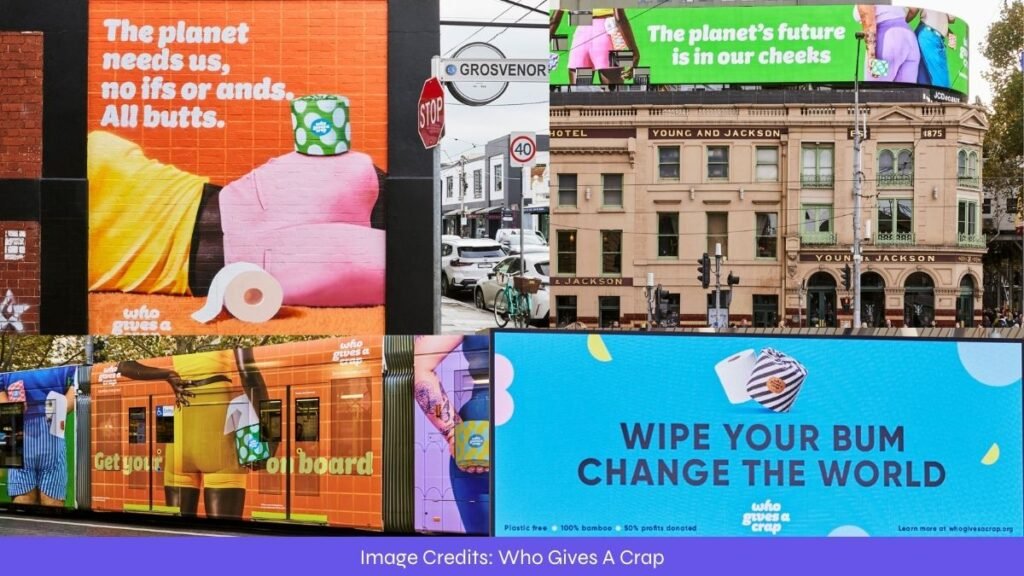
Bathroom brand Who Gives a Crap entered the market with a mission to provide affordable, sustainable toilet paper. On a limited marketing budget, they leveraged quirky guerrilla tactics to spread their message in major cities. Commuters found bathroom humor-based stickers plastered along train doors, while bars housed pun-ny pop-up displays.
Their boldest move involved an “emergency toilet paper run” through a busy park on Sunday mornings. Associates openly carted overflowing boxes branded “Who Gives a Crap – Since You’re Already Here…” and offered sheets to confused bystanders. This sparked social chatter and smiles about the timely topic.
Most notably, Who Gives a Crap paid backpackers to leave rolls with clever handwritten notes in remote Australian locations. Hikers appreciated the essential gift and photos online expanded brand recognition globally. By thinking outside the usual box and meeting consumers in eccentric ways, Who Gives a Crap wiped out competitors with a willingness to take risks on razor-thin budgets. Their toilet humor and environmental ethos clearly resonated through witty word-of-mouth.
Key Takeaways
- Always track guerrilla marketing efforts and quantify impact like leads, sales, traffic, etc. This helps assess ROI on tactics worth scaling up.
- Maintain brand consistency across guerrilla activities – visual identity, logo, messaging, etc. This builds recognition.
- For service startups, offer free trial sessions or lite versions of your service so people can sample value.
- Get creative in how you execute tried-and-tested guerrilla tactics. Inject innovation and differentiate from competitors.
While seemingly unconventional, guerrilla marketing done smartly allows early-stage startups to cost-efficiently build brand awareness and drive revenue traction. Before committing large budgets, startups can experiment with multiple guerrilla channels to identify what resonates most with target audiences.
Frequently Asked Questions
Is Guerrilla Marketing illegal?
Most guerrilla marketing is perfectly legal if done properly. Marketers should obtain permits where needed and avoid tactics like trespassing or damaging property. As long as it’s done safely and legally, guerrilla marketing taps into creativity rather than lawbreaking.
What are the 5 basic rules of Guerrilla Marketing?
The 5 basic rules of guerrilla marketing are:
1. Focus on imagination and creativity over budget
2. Use unconventional marketing tactics
3. Target a very specific audience
4. Create buzz and viral sharing
5. Focus on the goal rather than just brand awareness
How does Coca-Cola use guerrilla marketing?
Coca-Cola has used several creative guerrilla marketing tactics over the years. Some examples are installing vending machines with cameras to capture happy reactions, brand ambassadors giving out free cokes at events, interactive piano stairs that played music when stepped on, and their famous happiness truck that toured making people smile.
Which type of marketing costs less – traditional or guerrilla?
Guerrilla marketing almost always costs less than traditional marketing. Instead of investing in expensive TV/print ads, it focuses on low-cost, high-impact tactics like giveaways, stunts, pop-up events, street marketing, viral content, and leveraging social media.
What is an example of buzz marketing?
A classic example of buzz marketing is Hotmail’s decision to include a branded tagline on every outgoing email. This turned every user into a brand ambassador helping spread the word about Hotmail’s free email service. The viral nature helped them acquire 12 million users in just 18 months.
What is the average cost of guerrilla marketing?
The average cost of a guerrilla marketing campaign can range from a few hundred to a few thousand dollars. Since it relies on creativity over big budgets, costs stay low. Tactics like sticker campaigns, flash mobs, or pop-up events can be organized at very little cost.
